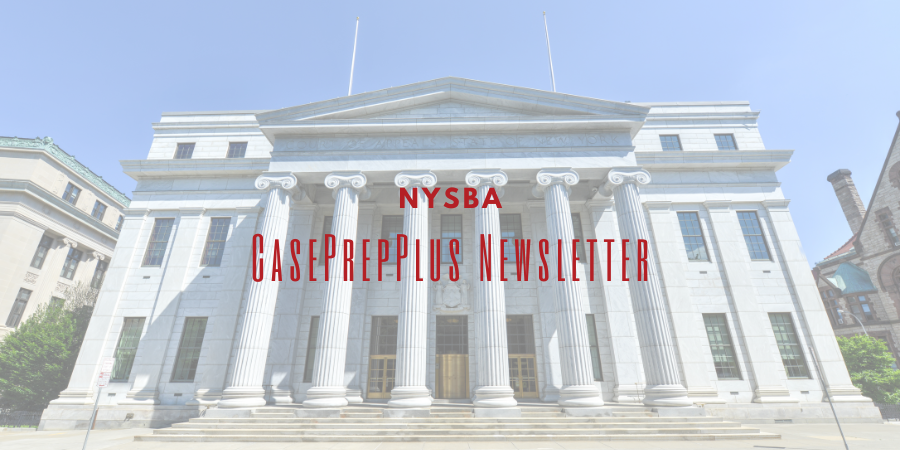
NYSBA CasePrepPlus Newsletter 11.17.23: Can Plywood on a Bathtub Qualify as a Scaffold under Labor Law § 240?
Let’s take a look what has been happening in New York’s appellate courts over the past week.
Appellate Division, First Department
Keilitz v Light Tower Fiber N.Y., Inc., 2023 NY Slip Op 05661 (1st Dept Nov. 09, 2023)
Construction Law, Labor Law § 240
Issue: Is pulling fiber optic cables underground through existing conduit “altering” work to qualify for protection under Labor Law § 240 where it part of a larger project, and can an object falling from ground level to the subsurface satisfy Labor Law § 240’s elevation-related risk requirement?
Facts: While working in subsurface manholes to pull fiber optic cables for installing a new fiber optic network for school buildings, the plaintiff was injured when a 20- to 30-pound vacuum fell into the manhole and struck the plaintiff in the head. In the plaintiff’s ensuing Labor Law § 240 action, Supreme Court dismissed the claim, holding that the plaintiff’s work to pull cables through existing conduit was not qualified “altering” work under section 240(1).
Holding: The First Department reversed and granted the plaintiff partial summary judgment on the Labor Law § 240 claim. The Court held, the plaintiff was “engaged in an ‘altering’ activity as enumerated by Labor Law § 240(1)” because his work “was part of a much larger, multi-worker project to install a fiber optic network through a 20-manhole structure where none had previously existed, with the ultimate goal of installing the cables into the school buildings, which would necessarily require drilling holes into the foundation of the school buildings in order to reach the communications room.” The Court further held, as a matter of law, that “the vacuum that fell from ground level into the manhole and struck plaintiff on the head posed the type of elevation-related risk covered by Labor Law § 240(1). The vacuum's initial position at ground level does not remove this case from the ambit of Labor Law § 240(1), given that the object fell onto plaintiff while he was working underground.”
Flores v Exotic Design & Wire LLC, 2023 NY Slip Op 05660 (1st Dept Nov. 09, 2023)
Construction Law, Labor Law § 240
Issue: Does a sheet of plywood placed on top of a bathtub qualify as a scaffold to offer a worker protection under Labor Law § 240?
Facts: The plaintiff was injured while framing a window after he fell three feet to the ground from a sheet of plywood that had been placed on top of a bathtub to facilitate his work. Supreme Court granted the plaintiff’s motion for partial summary judgment and denied the defendant’s cross motion for summary judgment dismissing the complaint.
Holding: The First Department affirmed, holding that the defendant had created the functional equivalent of a scaffold by “placing the plywood over the bathtub upon which plaintiff was required to work.” And the Court held, that the plaintiff’s fall was only three feet to the ground was insufficient to remove section 240’s elevation-related risk protection.
Appellate Division, Second Department
Torts, Duty to Supervise
Issue: Could a school be held liable, under a duty to supervise theory, for one student’s sexual assault of another?
Facts: After the plaintiff was sexually assaulted by another student on the school’s premises during the time after classes had ended, but before sports activities had begun, the plaintiff sued the school, alleging that it was liable for failing to provide adequate supervision that would have prevented the attack. Supreme Court denied the school district’s motion for summary judgment dismissing the complaint.
Holding: The Second Department held that to show a breach of the duty of adequate supervision, “it must be established that school authorities had sufficiently specific knowledge or notice of the dangerous conduct which caused injury; that is, that the third-party [student’s] acts could reasonably have been anticipated.” Here, the Court held, that wasn’t the case. The school demonstrated that it didn’t have “actual or constructive notice of the assailant’s potential for causing harm, as they submitted evidence that [the plaintiff] and the assailant had no previous significant interaction, and that the assailant’s disciplinary record did not include any sexually aggressive behavior.” The Court nevertheless held that summary judgment was properly denied because the school “failed to establish as a matter of law that the general security measures at the school were sufficient under the circumstances and that the incident occurred in such a short span of time that it could not have been prevented by the most intense supervision.”
Matter of P. C. v Stony Brook Univ., 2023 NY Slip Op 05604 (2d Dept Nov. 8, 2023)
School Law, CPLR Article 78, Substantial Evidence
Issue: Did substantial evidence exist to support the university’s determination that a student violated the Code of Student Responsibility regarding sexual misconduct?
Facts: During a night of heavy drinking, the petitioner and another student engaged in sexual activity. The following day, a Title IX complaint was filed with the University, alleging that the other student could not have consented to the sexual activity due to her intoxication and, thus, the petitioner violated the Code’s provisions requiring affirmative consent. The University Review Panel found the petitioner responsible for three violations and suspended him, finding that “‘regardless of whether [the other student] was or was not incapacitated by alcohol,’ the petitioner committed the violations because he had not obtained affirmative consent for the sexual acts in which he and [the other student] engaged.”
Holding: The Second Department, with two Justices dissenting, annulled the University’s determination as unsupported by substantial evidence. Importantly, the majority noted, because the Review Panel did not base its determination on the other student’s incapacity due to intoxication, that issue could not be considered by the Court in determining whether substantial evidence existed to support the determination. Rather, the only issue was “whether substantial evidence showed that [the other student], while able to consent, nevertheless did not do so.” On that question, the majority decided that the evidence on which the Review Panel relied—the other student’s statements to “leave [her] alone” and inability to remember the events the morning afterwards, and the petitioner’s text messages stating that he “f---- up” and refusal to answer questions during the investigation—when taken in proper context, did not support the Panel’s conclusion that “had not affirmatively consented to the sexual conduct in which she engaged with the petitioner.”
Appellate Division, Third Department
Matter of Cuer v State of New York, 2023 NY Slip Op 05643 (3d Dept Nov. 9, 2023)
Indemnification, State Employment
Issue: May a former state employee obtain indemnification from the State for his intentional sexual harassment of another state employee?
Facts: After a federal court judgment found the petitioner liable for sexual harassment and awarded the victim $2.8 million in compensatory and punitive damages, and the judgment was affirmed on appeal to the Second Circuit, the petitioner asked the State, his employer, to indemnify him for the award under Public Officers Law § 17(3) (a). When the State refused, the petitioner commenced an Article 78 proceeding to compel the State to indemnify him. Supreme Court denied the petition and dismissed the proceeding.
Holding: The Third Department affirmed, holding that “although Public Officers Law § 17 (3) (a) provides that the State shall indemnify its employees for a judgment or settlement provided that the act or omission which was the subject of the judgment or settlement occurred while the employee was acting within the scope of his [or her] public employment or duties, that duty does not extend to cases in which the injury or damage resulted from intentional wrongdoing on the part of the employee.” Here, because the federal jury already concluded that the petitioner’s actions in violation of Title VII were intentional wrongdoing, the State had a rational basis to deny him indemnification.
Calabrese v City of Albany, 2023 NY Slip Op 05641 (3d Dept Nov. 9, 2023)
Torts, Prior Notice
Issue: When a municipality promotes a system allowing the public to submit complaints to the municipality about street defects, can the municipality later assert that that system cannot be the “prior written notice” required before the municipality may be sued for injuries allegedly arising from defective streets?
Facts: Plaintiff was riding his motorcycle in the City of Albany when he lost control after striking a depression in the road and fell. He sued the City, and both parties moved for summary judgment, focusing on whether the City received prior written notice of the alleged defect, as required by Code of the City of Albany § 24-1 (A). Supreme Court denied both motions.
Holding: The Third Department affirmed, holding that the City’s prior written notice law was valid and required written notice be provided to the designated City employee—the Commissioner of the Department of General Services—before the City could be held liable for a defective street. The Court, however, rejected the City’s argument, as “troubling,” that the City’s “online reporting system identified as SeeClickFix . . . do not qualify as prior written notice . . . because they were not ‘sent to or received by the DGS Commissioner.’” Rather, the Court held, because the City promoted its online reporting system, it could not argue that that system could not be used to provide the prior written notice required. “Enforcement of that qualifier . . . would allow [the City] to encourage the public to utilize SCF to address real safety concerns, while at the same time deflating the legal impact of such a notice. [The City] cannot have it both ways.”
Appellate Division, Fourth Department
None.

